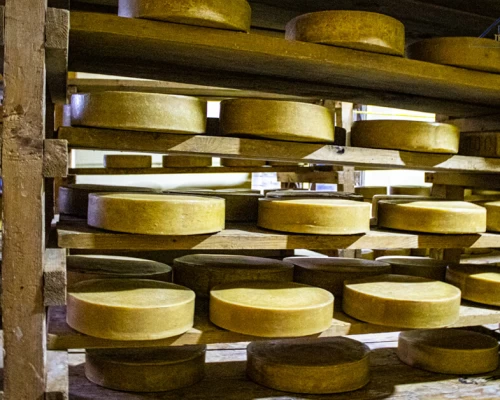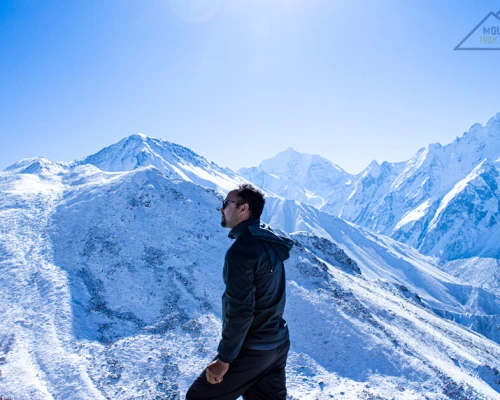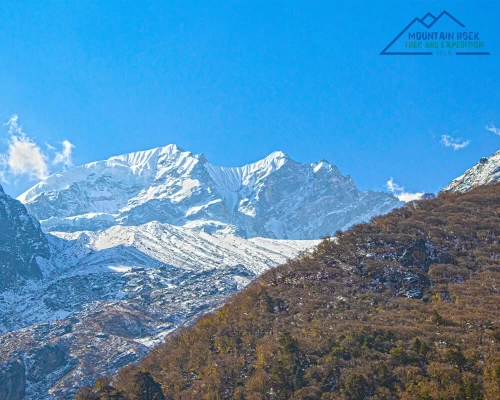Langtang Ganjala Pass Trek Route
Langtang Ganjala Pass Trek route starts from Kathmandu itself. You will do a bus drive of 7-8hrs to Syabrubesi. It will be a panoramic drive that will take you to the starting point of the trek. The next day, you’ll leave Syabrubesi for Lama Hotel. You’ll pass several villages, hills, and more on the route.
From Syabrubensi, the trek will happen toward Langtang Village via Ghore Tabela. You’ll trek through the jungle, by a river, and more. You’ll also come across Langtang Ri during the day. It will be a 5-6 hours trek to reach Langtang village. After Langtang Village, you’ll start another trekking day towards Kyanjin Gompa. It will be a walk along the region's mani walls and wooden bridges.
spend an acclimatization day in Kyanjin Gompa by doing a hike to Tsergo Ri. After two days in Kyanjin Gompa, you’ll move towards Nyengang Kharka by crossing suspension bridges, juniper trees, etc. After the overnight stay in Nyengang Kharka, you’ll hike upwards to the High Camp via glaciers and rock paths.
And finally, you’ll do a climbing trek to Ganja La Pass, the ultimate point of the tour. The path to the top is steep, rocky, and snowy.
Following the strenuous trek to Ganjala Pass, you’ll descend back to Keldang the same day. A hard walking day will end in Keldang’s tented camp. The following dawn, you’ll trek towards Dukpu to go far from the Ganjala Pass. That day will end in Dukpu. From Dukpu, you will move in the direction of Tarke Gyang. En route, you will pass several Sherpa villages.
After Take Gyang’s stop, it is time to trek towards Sermathang and enter the Helambu Region. It will happen via small forests and several hamlets and monasteries. Following this, you will move on the trail to find Melamchi Bazaar, the ending point of the trek. Finding Melamchi Bazaar will lead you to walk several more villages and terraced fields of the Helambu Region.
And it is time to finish the trekking part of Langtang Ganjala Pass Trek. You will join a jeep/bus drive of 6-7 hours to Kathmandu. This will be the completion of the Langtang Ganjala Pass Trek route.
About Langtang Region and Ganjala Pass
Langtang Region
Langtang Region is a region in the central-north part of Nepal. It is named after the region's famous mountain Langtang Lirung(7,234m/23,734ft). Turning into a favorite trekking destination, Langtang Region is not too far from Kathmandu, the capital of Nepal. It lies merely 51km north of the city. For that reason, it is called the nearest trekking region from Kathmandu.
The region is home to diverse flora and fauna, snow-covered mountains, and rich natural beauty. Above all, Langtang Region is known for the Tamang culture and lifestyle. Trekkers in Langtang Region can experience natural wonders as well as cultural wonders. This area is entirely inhabited by the Tamangs, an ethnic group highly inspired by Tibetan culture. So travelers will get to travel in Tibet without leaving the borders of Nepal.
As said earlier, the region is turning into a popular trekking destination. People can opt for this region if they want an off-the-beaten trekking experience in Nepal. This region is home to some of the best treks in Nepal. One of them is this very Langtang Ganjala Pass Trek.
others are Tamang Heritage Trek, Langtang Valley Trek, Helambu Circuit Trekking, Gosaikunda Lake Trekking, Langtang Gosaikunda Laurebina Pass Trek, and etc. Similarly, the major landmarks of the Langtang Region are Gosaikunda Lake, Ganja La Pass, Tserko Ri, Kyanjin Gompa, Langtang Village, Lama Hotel, Sermanthang, etc.
Ganjala Pass
Ganja La Pass(5,122m) is the ultimate point of Langtang Ganjala Pass Trek and a famous regional landmark. It is the center of attraction for trekkers, mainly adventurer lovers. Being the pinpoint of the challenging Langtang Ganjala Pass Trek, the mountain pass is touched by many trekkers every year.
The journey to the top of Ganjala Pass is demanding. You’ll cross many steep uphills, glacier sections, and iced paths. It will feel like climbing a mountain. However, the rewards of the walk are pretty breathtaking. You can even see Shishapangma, the 14th tallest peak globally, located in Tibet. The other viewable peaks from the pass are Langtang Lirung, Langtang Ri, Dorje Lakpa, Loenpo Gang, Changbu, Yansa Tsenji, Kyunga Ri, Yala Peak and more.
Permit Required for Langtang Ganjala Pass Trek
For Langtang Ganjala Pass Trek, you’ll need two permits. Langtang National Park Permit and Trekker Information Management System(TIMS Card). These two permits can be obtained from Kathmandu’s Nepal Tourism Board office. You do not have to arrange these permits if you go with us. Our team will arrange these permits in advance for you.
you trek through the protected Langtang National Park, you’ll need a license to enter the area. The Langtang National Park Permit costs USD 17 per person for SAARC nationals and USD 34 per person for other citizens. Similarly, TIMS Card is for the safety and security of Trekkers. The TIMS card is available for USD 6 per person for SAARC nationals and USD 20 per person for other residents. Fees, Passport Size photos, and photocopy of the passport are necessary for the permits.
Langtang Ganjala Pass Trek Difficulty Level
Langtang Ganjala Pass Trek is a moderate-rated trek in the Langtang Region. Half of the walk is moderate, and the other half is tricky. Therefore Ganjala Pass Trek is also famous as one of the most demanding treks in Nepal. The trek is regular and moderate until you are trekking through villages of the Langtang Region. But once you gain some altitude and reach Ganjala Pass, the walk turns dramatic.
The Ganjala Pass section is the demanding part of the entire trek. During the crossing of Ganjala Pass, you have to face adversities such as steep climbs, glacier walking, high altitude, and technical climbs. This part of the trek may feel like a day of a mountain expedition. If you have essential mountaineering experience, that will be a great help for you.
Besides Ganjala Pass, you’ll have some difficult times while climbing Tsergo Ri and Kyanjin Ri. Both of them involve high-altitude trekking and steep climbing. However, these two hikes will prepare you for the challenging Ganjala Pass climb.
Overall, Langtang Ganjala Pass Trek is an arduous trek if you are a newbie. It is a short trek, but there will be many challenges during this walk. High altitude, extreme weather, camped tent nights, technical climbs, glacier walking, rough terrain, and steep climbs are some of the trek challenges.
you know, challenges are there to overcome.
Langtang Ganjala Pass Trek Preparation
Langtang Ganjala Pass Trek will not be an easy trek for you. It is one of the most challenging treks in Nepal. This trek is for only two types of trekkers, experienced ones and prepared ones. If you are neither experienced nor prepared, you should not do this trek.
Let’s focus only on preparation for Langtang Ganjala Pass Trek. It is a demanding trek, and you’ll need a good physique and a good mindset. Above anything, you need to be the healthiest for the walk. Correspondingly, you need a body that can trek for 5-7 hours on average in the mountains. Cardiovascular training and strength training are the best ways to prepare for that.
Plan a training schedule with the right exercises and be focused on it. Swimming, jogging, cycling, hill hiking, and running are some excellent examples. Cardiovascular exercises make your lungs and body ready for the trek.
Likewise, strength training like sit-ups, pushups, pullups, squats, crunches, etc. Do treks that can familiarize you and your body with the Langtang Ganjala Pass Trek. This will help your body parts to build strengths. While doing all the physical training for the trek, you’ll also have a strong mindset. And that mindset will work wonders while on Langtang Ganjala Pass Trek.
So this is how you can prepare for the trek. Best wishes!
Langtang Ganjala Pass Trek Best Time
While planning Langtang Ganjala Pass Trek, the weather is the most crucial thing to look at. The weather can either spoil or color the whole trek. In simpler words, the tour becomes exciting when the weather is all right and saddening when the weather is not good. Hence the weather is an essential thing for this trek.
Keeping it straight, Autumn and Spring are the two great times for this or any other trek in Nepal. They are the so-called trekking seasons in Nepal. In contrast, Winter and Monsoon are less preferred times for tours in Nepal.
Langtang Ganjala Pass Trek in Autumn (September-November)
Autumn is a peak time for traveling in Nepal. The season has all the good weather conditions to offer. There is a stable weather pattern around the country. Similarly, the skies are clear, mountains are visible, and the temperature is warm during the Autumn months. Plus, the great festivals of Nepalese such as Dashain, Tihar, and Chaath, fall upon this season. So it is an excellent time for Ganjala Pass Trek.
Langtang Ganjala Pass Trek in Winter (December-February)
Winter is the next season after Autumn in Nepal. It is the start of the coldest season of the year. The first month, December is not that cold. However, Winter reaches its peak during January and February. The temperature throughout the country drops drastically. Likewise, heavy snowfall starts to occur in the mountains. This situation makes Winter not so favorable for trekking in the hills. It is possible in Winter, but the harsh weather makes it challenging.
Langtang Ganjala Pass Trek in Spring(March-June)
Spring takes over the country and spreads its colors following winter. Indeed, Spring is another hit time to visit Nepal. So you can do Langtang Ganjala Pass Trek during this season as well. This season has stable weather, clear panoramas, colorful landscapes, and low precipitation levels. Popular trails such as EBC Trek and ABC trek are crowded during this season. You can select this Langtang trek for a peaceful walk in this crowded spring.
Spring is over in Nepal, the wettest season of all rules the country. Monsoon Season(July-August) showers heavy rainfall all around the country. The routes get muddy, slippery, and landslide-prone. Likewise, the mountains remain under the clouds of the Monsoon. Hence, Summer or Monsoon is not the best time for this trek.
Food and Accommodation on Langtang Ganjala Pass Trek
Food
Food is not a problem on Langtang Ganjala Pass Trek, especially during the teahouse days. The trail has enough teahouses and lodges that offer food services to the trekkers. You can expect food items such as Dala Bhat, Momos, porridge, soup, canned tuna, pasta, momos, curries, etc. Drink items such as Soda, Tea, hot lemon, and coffee are also available during the trek.
Most of the food items are locally cultivated, and you’ll get to taste the real Langtang Region food. But, once you begin camping on the trek, the food items will get limited. Your kitchen staff will prepare limited meal options.
Accommodation
Like food, finding accommodation is also not a big deal in the Langtang region. There are lodges and tea houses along the route to provide reasonable accommodation. However, do not expect luxurious rooms at all. The rooms have basic shareable rooms with private rooms, wifi, and warm showers. This is for the teahouse section.
you know, you have to go camping on Langtang Ganjala Pass Trek. You will have to settle in tented camps for a couple of nights. While in those tented camps, you’ll sleep in sleeping bags.
Tips for Langtang Ganjala Pass Trek
- Langtang Ganjala Pass Trek is a challenging trek. Make sure you are well prepared physically and mentally for this adventure.
- Choose an appropriate time for the trek.
- Pack all the necessary things for the trek or hire them from Kathmandu.
- Do it with a licensed agency.
- Have an expert/local guide on the trek.
- Hire a porter if you have heavy backpacks.
- Take altitude sickness seriously and be cautious about it.
- Drink water to keep your body hydrated.
- Stroll calmly and take rests whenever needed.
- Do not go solo on the trek. It is an arduous trek to do alone.
- Ensure the trip with well-covering travel insurance.
- Spend enough acclimatization days.
.webp)
.webp)










